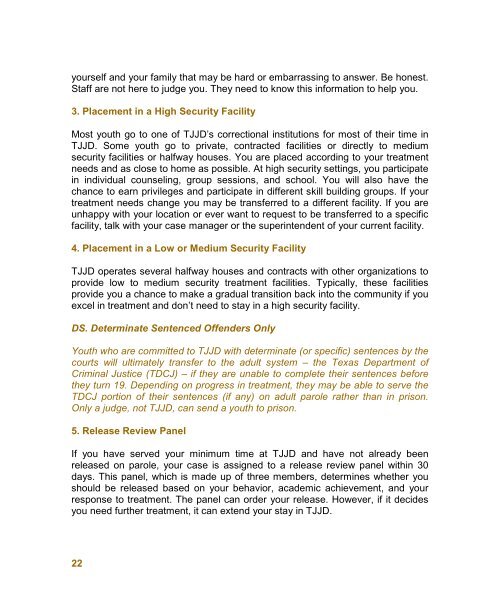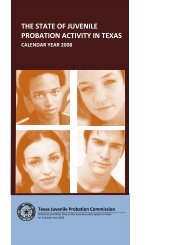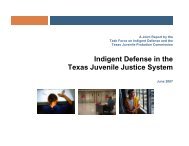(TJJD) Youth Handbook - Texas Juvenile Justice Department
(TJJD) Youth Handbook - Texas Juvenile Justice Department
(TJJD) Youth Handbook - Texas Juvenile Justice Department
Create successful ePaper yourself
Turn your PDF publications into a flip-book with our unique Google optimized e-Paper software.
yourself and your family that may be hard or embarrassing to answer. Be honest.Staff are not here to judge you. They need to know this information to help you.3. Placement in a High Security FacilityMost youth go to one of <strong>TJJD</strong>’s correctional institutions for most of their time in<strong>TJJD</strong>. Some youth go to private, contracted facilities or directly to mediumsecurity facilities or halfway houses. You are placed according to your treatmentneeds and as close to home as possible. At high security settings, you participatein individual counseling, group sessions, and school. You will also have thechance to earn privileges and participate in different skill building groups. If yourtreatment needs change you may be transferred to a different facility. If you areunhappy with your location or ever want to request to be transferred to a specificfacility, talk with your case manager or the superintendent of your current facility.4. Placement in a Low or Medium Security Facility<strong>TJJD</strong> operates several halfway houses and contracts with other organizations toprovide low to medium security treatment facilities. Typically, these facilitiesprovide you a chance to make a gradual transition back into the community if youexcel in treatment and don’t need to stay in a high security facility.DS. Determinate Sentenced Offenders Only<strong>Youth</strong> who are committed to <strong>TJJD</strong> with determinate (or specific) sentences by thecourts will ultimately transfer to the adult system – the <strong>Texas</strong> <strong>Department</strong> ofCriminal <strong>Justice</strong> (TDCJ) – if they are unable to complete their sentences beforethey turn 19. Depending on progress in treatment, they may be able to serve theTDCJ portion of their sentences (if any) on adult parole rather than in prison.Only a judge, not <strong>TJJD</strong>, can send a youth to prison.5. Release Review PanelIf you have served your minimum time at <strong>TJJD</strong> and have not already beenreleased on parole, your case is assigned to a release review panel within 30days. This panel, which is made up of three members, determines whether youshould be released based on your behavior, academic achievement, and yourresponse to treatment. The panel can order your release. However, if it decidesyou need further treatment, it can extend your stay in <strong>TJJD</strong>.22
















